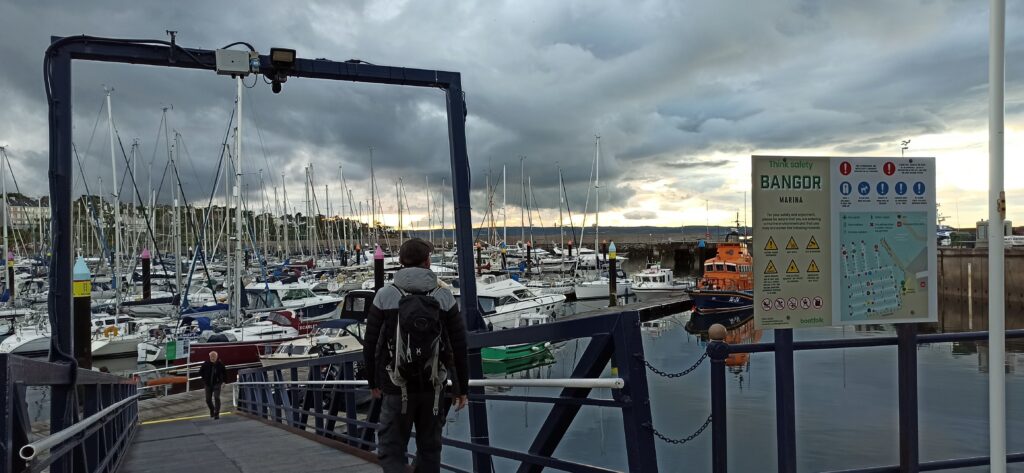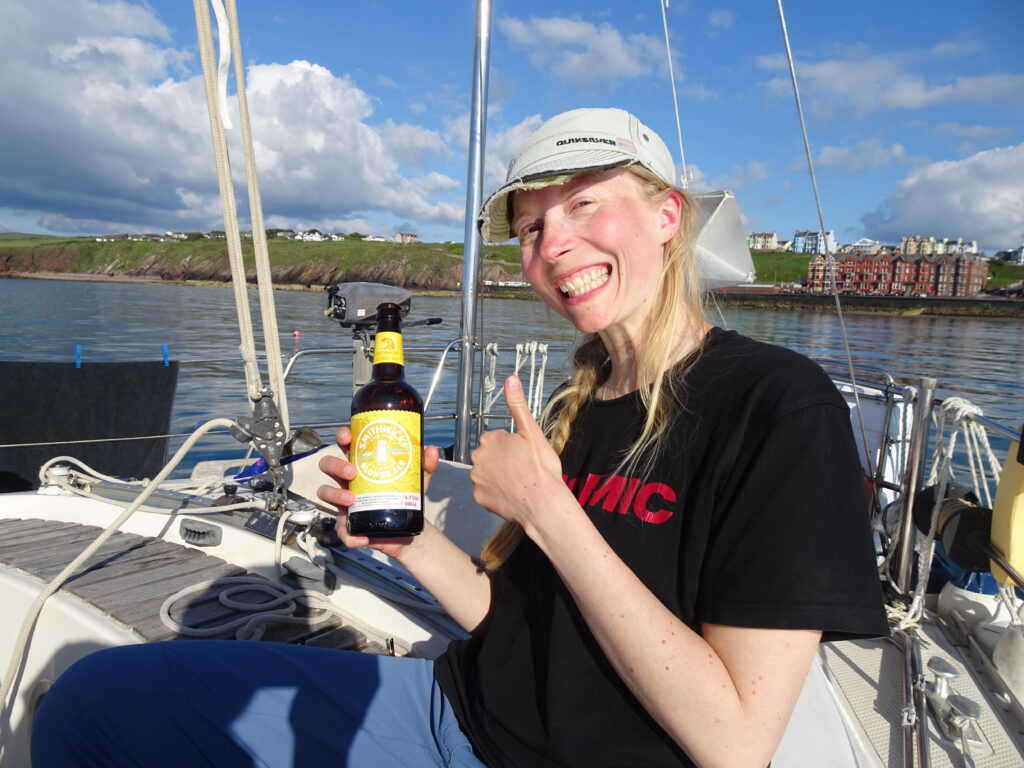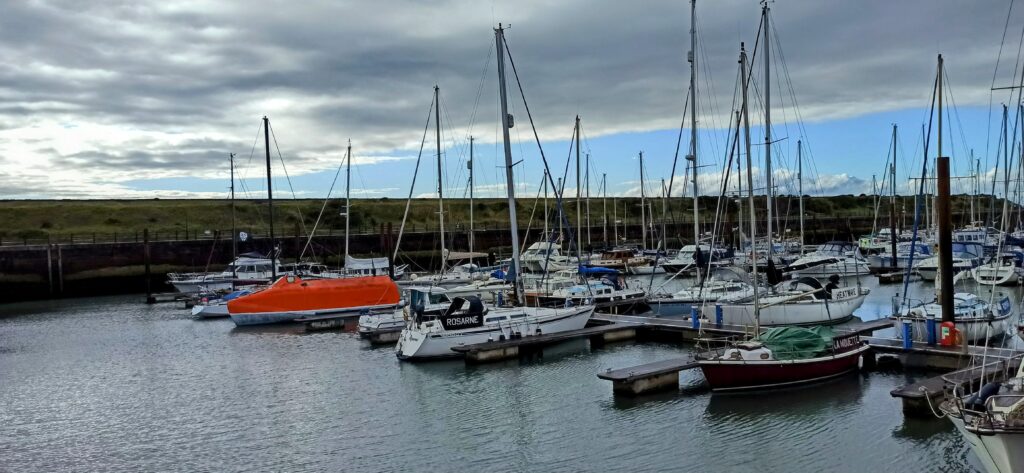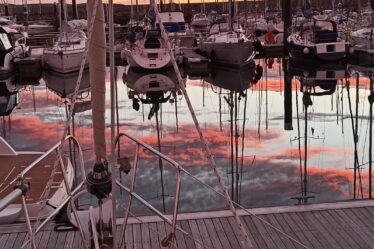Having arrived in Bangor, Northern Ireland, on a Saturday we had all of the following day to relax and explore. Early Sunday morning we headed away from the sea, hoping to leave the cold sea wind behind for a while. After wandering for about an hour we came across a vast park, green grass sprawling out between shrubberies. Paths leading this way and that, disappearing from sight down a hill or between clumps of trees. After a few hours there, feet happy to have been bare and nestled amongst the grass, we donned our shoes once more and continued back in a circuit to the centre of town.
Having arrived back at the marina, we followed a coastal path eastward passing the coloured buildings I had admired from the water up close. Most houses were kept up to a high standard, seemingly painted reasonably recently, though some others were showing clear wear from the sea air. The road led to a cove which was an obvious hotspot for watersports, a smatter of dinghies spread across the water enjoying the blue sky and gentle afternoon winds.

The following evening we walked west along the coast and we could see views down the river towards Belfast. Here we found a diagram gifted by the Bangor Rotary Club which showed the distance we were from different pieces of land, from nearby points in Northern Ireland all the way back to the Mull of Kintyre and Ailsa Craig in Scotland.


A few days later – Wednesday 1st June – and we were in luck with the weather once again. We were on our way with fair winds – enough to sail but with no worries of getting blown away. After a near-miss disaster while trying to exit the pontoon, resolved with some brute force from Miki and determination from me at the helm, we were on our way. Once safely out of the marina, making our way towards the lighthouse on Mew Island that would signify our moment to turn southeast, we took some time to discuss what had happened and what we could have done differently. This reflection is an important element we will have to build on over time in order to ensure safety and clear communication, so we are able to give this activity and the seas the respect they deserve.
Rounding the lighthouse, we changed heading towards the Isle of Man. Northern Ireland, the first country we’ve ever arrived to by sail, was on our starboard for the next couple of hours and eventually, we left it behind for the open waters of the Irish Sea.

We had called ahead the day before to enquire about mooring buoys at Peel Marina – it would be a much easier option to moor for the night, rather than trying to enter a marina which could only be accessed at certain times of the day due to changing tides. The harbour had confirmed there were buoys available and so we planned to hook up that night just outside Peel, the largest town on the west of the island.
Along the way we had our first glimpse of what long passages likely look like. With exceptionally calm waters and minimal wind there was very little we had to do for the rest of the journey, apart from staying alert for changing conditions and ensuring we were still on course. And with just one heading to reach our final destination, we could relax. We had time to chat enjoying random, heartfelt conversations, that we’d not had the chance to enjoy in months. I took time to write some notes in the logbook while Miki lounged at the helm, looking utterly at home.


Early evening we arrived at Peel. There were four bright yellow mooring buoys in the bay and all were empty. This was great! Less audience and obstacles for our first attempt catching a buoy as a duo. A short, reasonably uneventful, while later and we were safely attached to the buoy. With a few minor communication issues (namely – my mumbling from the bow of the boat being a useless indicator to Miki as to whether we had successfully caught the buoy, or whether he needed to round for another go) which we managed to deal with surprisingly well in our tired and hungry states.
Safely attached to what is essentially a permanent anchor we could breathe easy, taking in our surroundings and cracking open the two Irish beers we’d picked up in Bangor. Lying on deck; taking time to dip a toe (it turned out we couldn’t reach anything else from the stern platform!) into the chilly water; and watching the sun set over the rippling horizon.


We turned on the gas and cooked soup, the vibrant green Isle of Man visible just beyond the open hatch. It was an incredible end to a wonderfully slow day – exactly the kind of experience we’d both been dreaming of those previous ten months!

We headed to bed early that night, tired from the sea air, but also aware of our early start the following day.
Having planned the two days of our journey before leaving Bangor, we knew we needed to rise at around 4am on Thursday in order to be in tune with the tidal stream. Our final port was Maryport and it was only possible to enter at certain times of the day due to the tides, and especially as we couldn’t rely on our anchor, we didn’t want to miss our chance!
We’d planned it well. As we rounded the top of the Isle of Man the stream turned direction and helped carry us along. The Isle of Man was soon becoming a distant, hazy shape over our stern, Scotland had reappeared over portside and England was appearing through the mists over starboard. We passed what I can only describe as a jellyfish channel for ten minutes or more, a continuous line of jellies bobbing beneath the water, heading in the opposite direction to ourselves.

As the afternoon drew in the wind picked up a little, between wind and tide we’re doing 7-8 knots, no engine involved! Times had moved on from those first couple of days where I’d felt nervous at the helm every time our boat had rocked over the waves, this final day thrills of joy ran through me as we galloped across the sea. As the mists cleared over England the mountains of The Lakes could be seen from the water. An incredible vantage point I’d never enjoyed before.
The day had gone extremely well, we had been able to confidently turn off our engine knowing we were making good time for the lock gate. As the last couple of hours commenced however, nerves began to get a little fraught and communication between us was more of a challenge. The most difficult part of our sailing experience to date was about to begin.
There are many points around the UK where there are strong tidal currents, as well as a large difference between high and low tides. Maryport happens to be in the Solway, one of the more challenging areas. With Miki at the helm, he had to focus as the water fought to take control of our steering. I radioed into Maryport Marina in order to be given the go-ahead to enter – only one vessel at a time could enter or exit the marina due to the narrow channel you would need to navigate.

We were given clear instructions – after entering the first section between two walls, turn towards the marina once you had a clear view through the gates, not before, and not after, or you would likely ground your vessel! The last part wasn’t stipulated quite like that but was the obvious result. To this day we’re still not sure why they haven’t added a single marker or buoy to assist with this entry. Perhaps only those who can enter successfully are worthy of staying… Thankfully, we, and particularly Miki at that moment, were deemed worthy. Miki had to enter with increased speed in order to keep control of our boat while the tide pushed back, and suddenly we were in calm waters. We then judged the timing of the turn with the help of Navionics and made our way through the lock.
Coasting gently through the marina, we had eyes honed for the man who would be directing us towards our pontoon. One final moment of madness ensued as he waited on the wrong side, caused confusion on deck as we thought we had fenders (protective big balloon-like things) on the wrong side, and I half slipped, half scrambled to the other side, only for him calmly to walk round to the side we had prepared…!
And then it was over.
I felt a mixture of exaltation and deflation. Our fantastic feat, which had lasted several more weeks than planned, was done. Such an unbelievably proud moment for us. And yet, now it was done. Like the end of a life-changing trip, a festival or another grand event, the happiness was mixed with the blues.
We had brought the boat to Maryport so that we could keep it in a cheaper marina as we finished final work on board, and then put it up for sale. And so, I knew then that it was the last time we were to sail our boat. The entrance was too stressful a thing for us newbies to battle for a quick afternoon sail here and there. Should we damage the bottom during one of those navigations, plans of selling would go up in smoke – or perhaps more accurately, sink to the depths of the sea.
Though sailing as a whole is a journey we are far from finished travelling, the past months had put a lot of stress on us both and we needed time to regroup. To reflect and discuss, and to choose how best to move forward. An intensive learning experience like no other, and though there were many moments throughout when I wished we’d never begun, I am thankful for it all!
If you’d like to see the video for part two of our journey, click here




